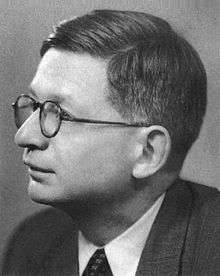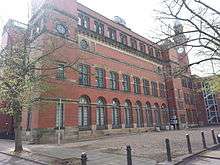Rudolf Peierls
Sir Rudolf Ernst Peierls, CBE (/ˈpaɪərlz/; German: [ˈpaɪɐls]; 5 June 1907 – 19 September 1995)[1] was a German-born British physicist who had a major role in Britain's nuclear programme, and also had a role in many modern sciences. His obituary in Physics Today describes him as "a major player in the drama of the eruption of nuclear physics into world affairs...".[2]
Early years
The son of Jewish parents, he assisted Egon Orowan in understanding the force required to move a dislocation which would be expanded on by Frank Nabarro and called the Peierls–Nabarro force. In 1929, he studied solid-state physics in Zurich under the tutelage of Werner Heisenberg and Wolfgang Pauli. His early work on quantum physics led to the theory of positive carriers to explain the thermal and electrical conductivity behaviours of semiconductors. He was a pioneer of the concept of "holes" in semiconductors.[3] He actually established "zones" before Léon Brillouin, despite Brillouin's name being currently attached to the idea, and applied it to phonons. Doing this, he discovered the Boltzmann equations for phonons and the Umklapp process. Physics Today states "His many papers on electrons in metals have now passed so deeply into the literature that it is hard to identify his contribution to conductivity in magnetic fields and to the concept of a hole in the theory of electrons in solids".[2]
Leading up to World War II
He was studying on a Rockefeller Scholarship at Cambridge University when Adolf Hitler came to power in his native Germany. Granted leave to remain in Britain, he worked in Manchester under a fund set up for refugees, with Hans Bethe on photodisintegration and the statistical mechanics of alloys when asked by James Chadwick. Their results still serve as the basis for mean-field theories of structural phase changes in complete alloys. Moving back to Cambridge, he worked with P. G. L. Kapur at the Mond Laboratory on superconductivity and liquid helium. The group derived the dispersion formula for nuclear reactions originally given in perturbation theory by Gregory Breit and Eugene Wigner, but now included generalising conditions. This is now known as the Kapur–Peierls derivation. In 1937, he became Professor of Mathematical Physics at the University of Birmingham.[2]
World War II
In 1939, he started working on atomic research with Otto Robert Frisch and James Chadwick. Ironically, both Peierls and Frisch were excluded from working on radar (then known as RDF) as it was considered too secret for scientists with foreign backgrounds. Peierls naturalised as a British subject on 27 March 1940.[4]
Frisch–Peierls memorandum
In March 1940, he co-authored the Frisch–Peierls memorandum with Otto Robert Frisch. This short paper was the first to set out how one could construct an atomic bomb from a small amount of fissionable uranium-235. They calculated that about 1 kg would be needed.[5] Until then it had been assumed that such a bomb would require many tons of uranium, and consequently was impractical to build and use. The paper was pivotal in igniting the interest of first the British and later the American authorities in atomic weapons. In 1941 its findings made their way to the United States through the report of the MAUD Committee, an important trigger in the establishment of the Manhattan Project and the subsequent development of the atomic bomb. He was also responsible for the recruitment of his compatriot Klaus Fuchs to the British project, an action which was to result in Peierls falling under suspicion when Fuchs was exposed as a Soviet spy in 1950. In 1999, The Spectator garnered outrage from his family when they alleged Rudolf Peierls was a spy codenamed "perls" for the Soviet Union.[6]
Manhattan project
Following the signing of the Quebec Agreement in August 1943, Peierls joined the Manhattan Project, located in the United States. Peierls was part of the British team, along with Klaus Fuchs, whom he recruited for the project. Peierls was initially located in New York and later at the Los Alamos Laboratory, where he played an important role in the development of the atomic bomb.
Post-war
After the war, Peierls reassumed his position in the physics department at the University of Birmingham where he worked until 1963 before joining the University of Oxford as Wykeham Professor of Physics. At Birmingham he worked on nuclear forces, scattering, quantum field theories, collective motion in nuclei, transport theory, and statistical mechanics. Also while at Birmingham, he worked as a consultant to the British atomic programme at Harwell. He retired from Oxford in 1974. He wrote several books including Quantum Theory of Solids, The Laws of Nature (1955), Surprises in Theoretical Physics (1979), More Surprises in Theoretical Physics (1991) and an autobiography, Bird of Passage (1985). Concerned with the nuclear weapons he had helped to unleash, he worked on the Bulletin of the Atomic Scientists, was President of the Atomic Scientists' Association in the UK, and was a major player in the Pugwash movement.[2]
Honours
Peierls was appointed a Commander of the Order of the British Empire in the 1946 New Year Honours and was knighted in the 1968 Birthday Honours.[7][8] He was invited to deliver the Rutherford Memorial Lecture in 1952, was awarded the Lorentz Medal in 1962, and in 1980 he received the Enrico Fermi Award from the United States Government for exceptional contribution to the science of atomic energy.[9]
Personal life
He attended a physics congress in Odessa in August 1930 and met a young physics student, Eugenia Kannegiesser (b.1908), from Leningrad. English was their shared language though Eugenia's English was limited. During a visit to lecture in Leningrad in 1931 they married. However, she had to wait for a passport and exit visa. They finally left for Zürich that summer. They had four children, Gaby Ellen (b.1933), Ronald Frank (b.1935), Catherine (Kitty; b.1948), and Joanna (b.1949). Eugenia died in 1986.[10]
Legacy

On 2 October 2004, the building housing the sub-department of Theoretical Physics at the University of Oxford was formally named the Sir Rudolf Peierls Centre for Theoretical Physics.
See also
References
- ↑ Lee, S. (2007). "Rudolf Ernst Peierls. 5 June 1907 -- 19 September 1995: Elected FRS 1945". Biographical Memoirs of Fellows of the Royal Society. 53: 265. doi:10.1098/rsbm.2007.0003.
- 1 2 3 4 Edwards, S. (1996). "Rudolph E. Peierls". Physics Today. 49 (2): 74–75. Bibcode:1996PhT....49b..74E. doi:10.1063/1.2807521.
- ↑ 1. R.E. Peierls, "Zur Theorie der galvanomagnetischen Effekte", 1929. 2. R.E. Peierls, "Zur Theorie des Hall Effekts", 1929. The English translation of these 2 papers can be found in "Selected Scientific Papers of Sir Rudolf Peierls", edited by R H Dalitz & Sir Rudolf Peierls, World Scientific, 1997.
- ↑ "No. 34844". The London Gazette. 7 May 1940. p. 2717.
- ↑ Sherrow, Victoria. The Making of the Atom Bomb. San Diego: Lucent Books, 2000. 24
- ↑ Durrani, Matin (1 July 1999). "New spy claims meet firm denial". Physics World. Archived from the original on 17 February 2012. Retrieved 27 January 2004.
- ↑ "No. 37407". The London Gazette. 1 January 1946. p. 51.
- ↑ "No. 44600". The London Gazette (Supplement). 8 June 1968. p. 6300.
- ↑ Laureates at the Wayback Machine (archive index)
- ↑ Dalitz, Richard (2008) [2004]. "Peierls, Rudolf Ernst (1907–1995)". Oxford Dictionary of National Biography (online ed.). Oxford University Press. doi:10.1093/ref:odnb/60076. (Subscription or UK public library membership required.)
External links
- 1979 Audio Interview with Sir Rudolf Peierls by Martin Sherwin Voices of the Manhattan Project
- Selected Scientific Papers of Sir Rudolf Peierls, edited by R. H. Dalitz & Sir Rudolf Peierls, World Scientific Series in 20th Century Physics, Volume 19, 1997.
- Sir Rudolf Peierls: Selected Private and Scientific Correspondence Volume 1, by Sabine Lee (University of Birmingham, UK).
- Pictures in the National Portrait Gallery, London.
- Rudolf Peierls own biographical notes from Los Alamos National Laboratory as a pdf
- War and Peace in the Nuclear Age; Dawn; Interview with Rudolf Peierls, 1986
- O'Connor, John J.; Robertson, Edmund F., "Rudolf Peierls", MacTutor History of Mathematics archive, University of St Andrews.
- Rudolf Peierls at the Mathematics Genealogy Project
- FBI file on Rudolf and Eugenia Peierls at vault.fbi.gov

